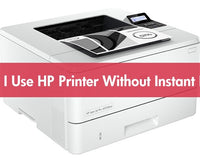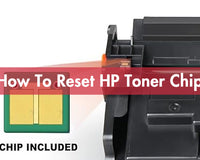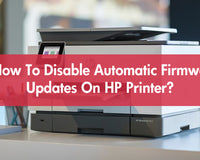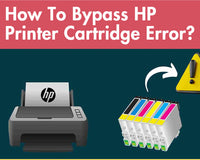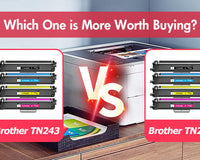Encountering issues where your printer starts printing blank pages can be a frustrating experience, especially when it comes to high-volume printers like HP or Epson models. Whether you're wondering, 'Why is my printer printing blank pages?' or specifically, 'Why is my HP printer printing blank pages?' or 'Why is my Epson printer printing blank pages?', the root causes often share similarities. Our blog at True Image aims to explore the common reasons behind this problem and provide solutions to help you troubleshoot and resolve the issue quickly, restoring your printing capabilities to their full potential.
Introduction of Why My Printer Printing Blank Pages
Printer printing blank pages is a prevalent one faced by many users of printers, regardless of the brand. Specifically, the printer is unexpectedly printing blank pages instead of the intended document or image. This unexpected behavior can be frustrating and disruptive to workflows, demanding a swift and accurate solution.
Brief Overview of Why My Printer Printing Blank Pages
The reasons behind a printer printing blank pages can vary. Some common potential causes include ink or toner cartridge issues, clogged print heads, printer settings being incorrectly configured, or hardware malfunctions. In addition, the problem could be specific to certain printer brands, such as HP or Epson, where certain models may have known issues or quirks that can lead to blank page printing.
Importance of Addressing Printer Printing Blank Pages Promptly
Addressing the issue of a printer printing blank pages is crucial for maintaining productivity and efficiency. Failure to address this issue can result in wasted paper and ink, increased costs, and possible delays to critical workflows. By promptly diagnosing and fixing the root cause, users can restore their printers to normal functioning and avoid further inconvenience or financial loss.

Common Causes of Printer Printing Blank Pages
Ink or Toner Issues
- Low Ink or Toner Levels: Low ink or toner levels can lead to blank pages as the printer struggles to produce images with insufficient ink. It is important to monitor ink levels and replace cartridges when necessary.
- Ink or Toner Cartridges Not Properly Seated: Ink or toner cartridges not properly seated can result in poor printing quality or even blank pages. Ensure that cartridges are inserted correctly and firmly into their slots.
- Use of Incompatible Cartridges: The use of incompatible cartridges can cause various printing issues, including blank pages. Always use cartridges that are specifically designed and approved for your printer model.
By the way, for reliable cartridge replacements, choose from True Image. We offer reliable Brother ink and toner cartridge replacements, Canon ink and toner cartridge replacements, Kyocera ink and toner cartridge replacements, and so on.
Hardware Problems
- Print Head Issues: Print head issues, such as clogged nozzles, can lead to blank pages. Performing a nozzle check and cleaning the print head can help resolve this issue. If necessary, the print head may need to be replaced.
- Paper Feed Rollers Not Working Properly: Paper feed rollers not working properly can prevent paper from being fed into the printer correctly, resulting in blank pages. Check the rollers for dirt or debris and clean them if necessary.
- Defective Printer Parts: Defective printer parts, such as the drum unit or fusing assembly, can also lead to blank pages. These parts may need to be replaced to restore normal printing.
Software or Driver Issues
- Outdated Printer Drivers: Outdated printer drivers can cause compatibility issues with your operating system and printer software, resulting in blank pages. Keep your printer drivers updated to ensure optimal performance.
- Printer Settings Not Correctly Configured: Printer settings not correctly configured can lead to blank pages. Check your print settings, such as paper size and print quality, to ensure they are set correctly for your printing task.
- Issues with the Printing Software or Application: Issues with the printing software or application can sometimes result in blank pages. Try printing from a different application or reinstalling the printer software to troubleshoot this issue.
Paper Issues
- Incompatible Paper: Using paper that does not meet the printer specifications can cause issues with both HP and Epson printers, resulting in blank pages. This includes using paper that is too thick, too thin, or has an incompatible coating.
- Paper Loading: If the paper is not loaded correctly in the paper tray, it can cause the printer to fail to pick up the paper or feed it through the printer correctly, resulting in blank pages.
- Paper Curl or Dampness: Paper that is curled or damp can cause issues with the printer's paper feed mechanism, leading to blank pages or misaligned prints.

Document Content
- Blank Document Content: The issue may arise from the document itself, which may contain unintentional blank pages or areas regardless of the printer brand. Blank pages can occur if it contains hidden blank paragraphs, or if the document file was corrupted during transmission or editing. Additionally, large tables or graphics in the document may be followed by a blank page that can only be deleted by adjusting the table or graphic size.
- Formatting Issues: Formatting issues in the document, such as incorrect page breaks or margins, can sometimes cause parts of the document not to print correctly, resulting in blank areas on the page.
Note: If you encounter blank pages, it is recommended first to check the ink levels and ensure that the ink cartridges are properly seated. If the problem persists, consider performing a nozzle check and cleaning the print head.
Additionally, check your printer's control panel for any error messages or indications that may point to a hardware issue. If necessary, manually clean the paper feed rollers using a lint-free cloth to remove any dirt or debris that may be affecting the flow of paper into the printer.
Troubleshooting Steps for Why Is My Printer Printing Blank Pages?
Check Ink or Toner Levels
- Verify Ink or Toner Levels: Open the printer's control panel or use the printer software to check the ink or toner levels. Ensure that all ink cartridges or toner cartridges have sufficient ink or toner.
- Replace Cartridges if Necessary: If any of the ink cartridges or toner cartridges are low or empty, remove the cartridge carefully and replace it with a new one. Ensure that you use cartridges that are compatible with your printer model.
Hardware Inspection
- Ensure Cartridge Placement: Verify that the ink or toner cartridges are securely seated in their designated slots.
- Clean Key Components: Use a lint-free cloth or the printer's cleaning function to clean the print head and paper feed rollers thoroughly.
- Inspect for Damage: Carefully examine the printer for any visible damage, such as broken parts or frayed wires.
- Stable Placement: Ensure the printer is resting on a flat, stable surface to prevent potential issues with paper feed and printing quality.
Software Management
- Update Drivers: Check for and install any available updates for your printer drivers to maintain compatibility with your operating system. Outdated drivers can cause compatibility issues with your operating system and printer software, which may result in printing blank pages.
- Reset Configurations: Reset your printer settings to the default or recommended configurations to resolve potential software conflicts. Incorrect settings, such as, paper size and printing quality, can sometimes lead to printing blank pages. Take HP printer as an example, you can reset HP print settings in Windows, Mac, HP smart.
- Test Printing: Perform test prints from different software or applications to identify if the issue is specific to a certain program.
Perform a Nozzle Check
Use the printer's software or control panel to perform a nozzle check, which will help you identify if there are any clogged nozzles. If the nozzle check reveals clogged nozzles, you can try manually cleaning the print head using a lint-free cloth and the printer's cleaning function.
Paper and Document Verification
- Check Paper Specs: Verify that the paper you're using meets the specifications recommended by your printer's manual.
- Review Document Content: Before printing, carefully review the document content to ensure there are no blank pages or areas that could cause unexpected printing results.
Remember, these are general troubleshooting steps and may vary depending on your printer model and specific issue. If you continue to experience printing blank pages, consult your printer's manual or contact technical support for further assistance.
FAQs About Why My Printer Is Printing Blank Pages
Why Is My HP Printer Printing Blank Pages?
As for the reason why is my HP printer printing blank pages, you may find the answer in "Common Causes of printer Printing blank pages" in this blog. Low HP ink levels, clogged print heads, and incorrect print settings, just to name a few, are common causes of HP printers printing blank pages. It's critical to check ink levels, clean the print head, and modify print settings in order to troubleshoot this issue.
Why Is My Epson Printer Printing Blank Pages?
When it comes to the reason why is my Epson printer printing blank pages, you can also refer to “common causes of printer printing blank pages” in this blog. Your Epson printer may be printing blank pages due to low or empty ink cartridges, clogged print head nozzles, blank document content, and so on.
By the way, ensuring a smooth flow of ink is crucial for a printer to function properly and avoid printing blank pages. If encountering the issue of printing blank pages, the first step should be to check the status of the ink cartridges and the print heads to determine if there are any issues with the ink flow or clogs in the print heads.
Advice For Why My Printer Is Printing Blank Pages
To avoid your printer printing blank pages, here are some specific advice and steps you can take:
- Regularly Clean the Printhead: Most printers have a printhead cleaning feature that you can access through the printer's software or settings. Use this function regularly to remove any ink residue or clogs that may be preventing ink from flowing properly.
- Check for Empty or Low Ink Cartridges: Before printing, always check the ink levels in your cartridges. Replace any empty or low cartridges immediately to avoid running out of ink mid-print.
- Use Quality Ink Cartridges: Ensure you are using genuine or compatible ink cartridges that are designed for your printer model. Low-quality cartridges may cause various printing issues, including blank pages. We offer cost-effective and high-quality ink and toner cartridge replacements, such as HP 219X, Brother TN249, and Canon 069H cartridge replacements.
- Store Cartridges Properly: If you have cartridges that are not currently in use, store them in a cool, dry place to maintain their quality and prevent damage. Avoid extreme temperatures or humidity, which can ruin ink cartridges.
- Update Your Printer Drivers: Ensure your printer drivers are up to date. Outdated drivers can cause communication issues between your printer and computer, leading to printing problems.
- Check the Paper: Use paper that is designed for your printer model and is of good quality. Avoid using wrinkled, damp, or low-quality paper, which can cause printing issues.
By following these steps, you can help avoid the most common issues that lead to blank page printing and ensure your printer operates smoothly.
Further Reading
1.Epson Printer Printing Blank Pages - Fixed
2.[Fixed] Why Is My Canon Printer Printing Blank Pages
3.Printer Not Printing in Color - Fixed
4.Printer Leaving Black Streaks Fix












